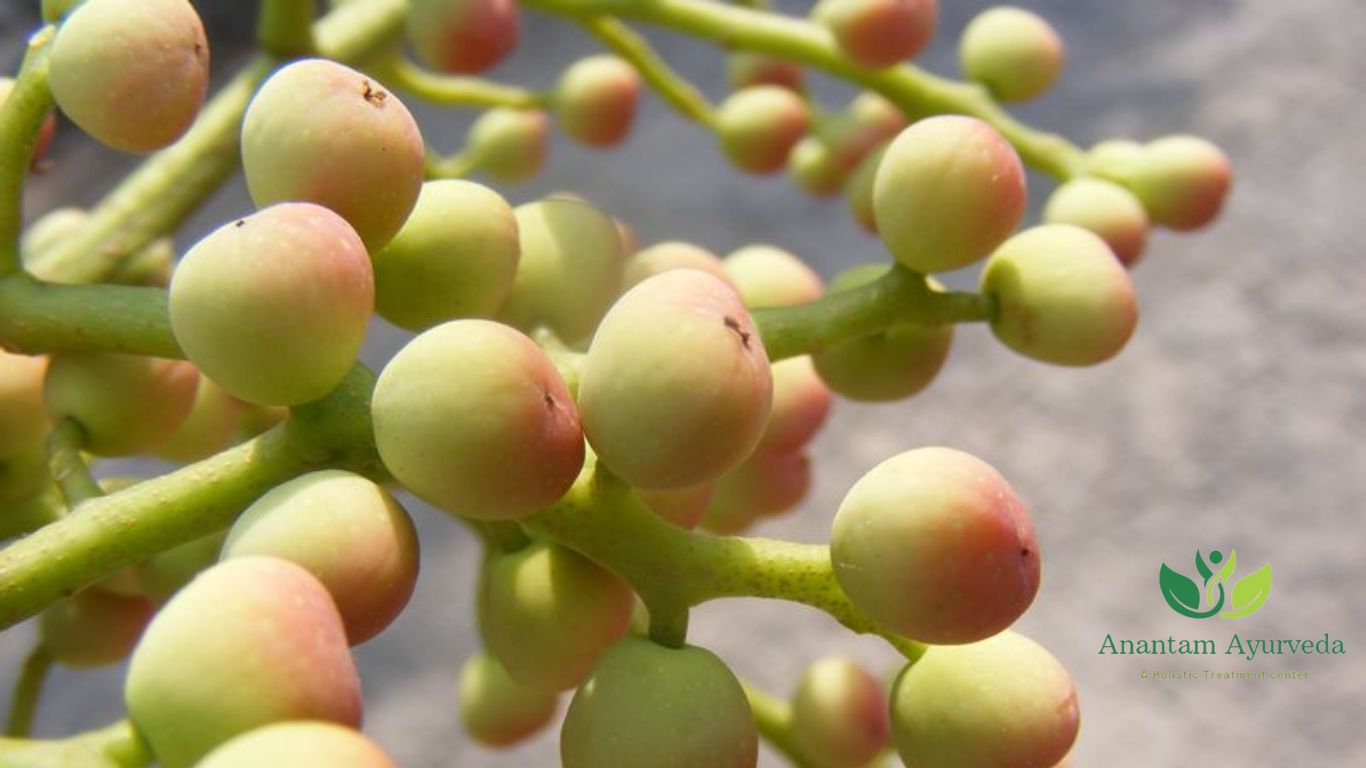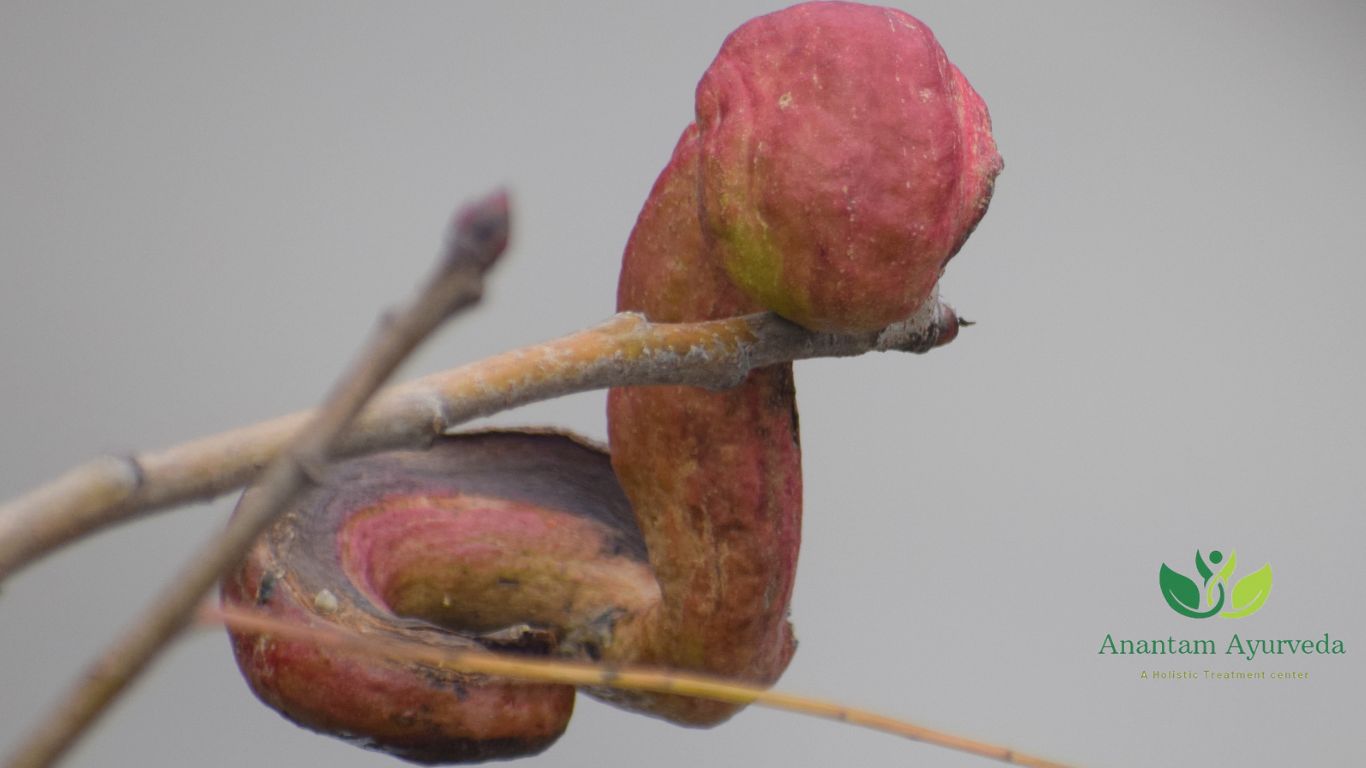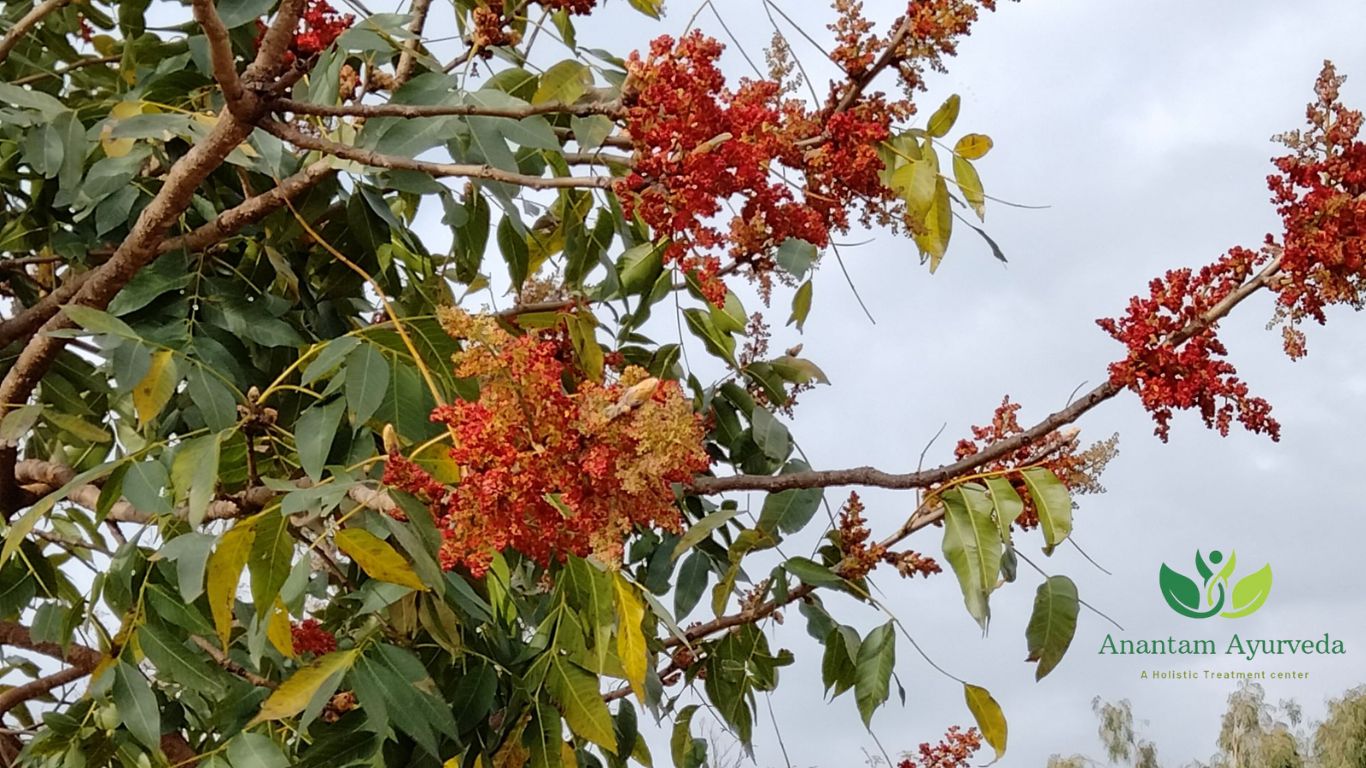Karkatshringi (Pistacia integerrima): Karkatshringi Uses
Introduction to Karkatshringi in Ayurveda
Karkatshringi, scientifically known as Pistacia integerrima, is one of the most treasured herbs in classical Ayurveda. This botanical marvel, often referred to as “Galls of Pistacia”, plays a significant role in the management of respiratory ailments, fevers, and digestive disorders. The term Karkatshringi refers to the horn-like galls that form on the leaves due to insect infestation, and it is these galls that hold immense therapeutic value.
Found predominantly in the sub-Himalayan regions of India, including Himachal Pradesh, Uttarakhand, and parts of Kashmir, this herb is deeply embedded in ancient Ayurvedic pharmacopeia for its Kapha-Vata balancing properties and anti-inflammatory, expectorant, and immunomodulatory actions.

Common and Regional Names of Karkatshringi
Understanding the various regional and classical names of Karkatshringi reveals its widespread recognition across India.
-
Hindi: Kakadasingi
-
Malayalam: Kakadashingi
-
English: Galls of Pistacia, Crab’s Horn
-
Botanical Name: Pistacia integerrima
-
Family: Anacardiaceae
Sanskrit Synonyms of Karkatshringi
Karkatshringi is referred to by several Sanskrit synonyms, each depicting a unique quality or morphological feature of the plant:
-
Kulira Vishanika – The gall resembles the horn of a crab.
-
Ajashrungi – The galls resemble the horn of a goat.
-
Shringi – Indicates its power to cure diseases like Kasa (cough), Shwasa (dyspnea), and Balaroga (childhood disorders).
-
Vishanika – Denotes horn-like appearance of the gall.
-
Vakra – The galls are naturally curved.
Classical Categorization of Karkatshringi
Charaka Samhita classifies Karkatshringi under:
-
Kasahara Gana – Group of herbs beneficial in relieving cough.
-
Hikka Nigrahana Gana – Herbs effective in suppressing hiccups.
-
Madhura Skandha – Herbs known for their sweetness in taste or post-digestive effect.
Sushruta Samhita includes Karkatshringi in:
-
Kakolyadi Gana – A group associated with rejuvenation and strengthening vitality.
-
Padmakadi Gana – Known for cooling and calming properties, often used in fevers and inflammation.
Distribution and Habitat of Karkatshringi
Karkatshringi is native to the north-western Himalayan region, and also grows in:
-
Punjab
-
Himachal Pradesh
-
Uttarakhand
-
Uttar Pradesh (hill tracts)
It thrives well on Himalayan slopes, sub-alpine hills, and semi-arid regions, typically found at altitudes ranging between 600 to 2400 meters.
Morphology and Identification of Karkatshringi
-
Habit: Medium-sized deciduous tree, glabrous (smooth and hairless) in nature.
-
Leaves: Imparipinnate, leaflets arranged in opposite pairs, typically 4–5 pairs per leaf. Margins are entire and veins are reticulate.
-
Inflorescence: Panicle type, bearing both male and female flowers.
-
Flowers: Male flowers have stamens longer than sepals; female flowers possess four linear sepals.
-
Fruits: Drupe, glabrous, turns gray when ripe.
-
Galls (Shringi):
-
Horn or curved in shape.
-
Can grow up to 15 cm in length.
-
Outer surface: Rough, pinkish-purple or dark brown, with a fimbriated (fringed) appearance.
-
Inner surface: Reddish brown, often covered with fine dust-like particles, which are residues of dried insects and their excretions.
-

Phytochemical Constituents of Karkatshringi (Pistacia integerrima)
Karkatshringi is rich in diverse bioactive phytochemicals, which are responsible for its broad spectrum of therapeutic effects in Ayurveda. These constituents contribute to its antimicrobial, antioxidant, anti-inflammatory, expectorant, and immunomodulatory properties.
1. Tannins
Tannins are the most abundant phytoconstituents in Karkatshringi galls. They provide a strong astringent property, making the herb effective in controlling diarrhea, bleeding disorders, and mucosal inflammations. Tannins also exhibit antiviral and antibacterial activities.
2. Flavonoids
Flavonoids such as quercetin, kaempferol, and rutin have been identified in the plant. These compounds have potent antioxidant properties that help combat oxidative stress, reduce inflammation, and support immune modulation.
3. Alkaloids
Alkaloids present in Karkatshringi contribute to its bronchodilator, stimulant, and anti-cough actions. They play a significant role in managing respiratory disorders, especially in children.
4. Glycosides
These compounds support digestive health, help reduce fever, and provide immunostimulant effects. Glycosides are also associated with enhancing the bioavailability of nutrients in herbal formulations.
5. Essential Oils
The essential oils extracted from the galls exhibit antiseptic, expectorant, and carminative actions. They are beneficial in treating cough, cold, and digestive discomfort.
6. Terpenoids
Karkatshringi contains monoterpenes and sesquiterpenes, which contribute to its anti-inflammatory and antimicrobial activities. These are crucial in fighting infections and promoting tissue healing.
7. Gallic Acid
Gallic acid, a type of phenolic compound, has shown strong antioxidant and cytoprotective properties. It aids in reducing oxidative damage and inflammation in respiratory tissues.
8. Ellagic Acid
Known for its anti-viral and anti-mutagenic effects, ellagic acid also contributes to the immune-supportive and detoxifying properties of the plant.
Medicinal Properties of Karkatshringi
Rasa (Taste)
-
Kashaya (Astringent)
-
Tikta (Bitter)
Guna (Qualities)
-
Laghu (Light to digest)
-
Ruksha (Dry)
Virya (Potency)
-
Ushna (Hot in potency)
Vipaka (Post-digestive effect)
-
Katu (Pungent)
Pharmacological Actions of Karkatshringi
-
Astringent – Contracts tissues and reduces secretions.
-
Tonic – Strengthens and rejuvenates body systems.
-
Expectorant – Clears mucus from the airways.
-
Stimulant – Activates physiological processes.
-
Swasahara – Alleviates breathlessness.
-
Kasahara – Relieves different types of cough.
-
Rochaka – Improves appetite.
-
Chardighna – Prevents nausea and vomiting.
-
Atisarajit – Useful in controlling diarrhea.

Medicinal Uses of Karkatshringi
1. Powerful Remedy for Respiratory Disorders
Karkatshringi is extensively used in the treatment of chronic cough, asthma (Tamaka Shwasa), bronchitis, and whooping cough. Its expectorant properties help in liquefying and expelling mucus from the lungs, providing relief in productive and dry cough.
2. Effective in Pediatric Disorders
In classical Ayurveda, it is widely prescribed for children’s respiratory problems such as Kasa, Shwasa, and Jwara. Combined with honey and Sitopaladi churna, it proves to be a soothing and safe remedy for infants and toddlers.
3. Immunomodulatory and Antioxidant Properties
Karkatshringi has demonstrated significant antioxidant activity, helping combat oxidative stress. Its role in enhancing natural immunity (Ojas vardhaka) makes it valuable in the prevention of recurrent infections.
4. Digestive and Anthelmintic Actions
The herb is also used to improve digestion, eliminate intestinal worms, and relieve conditions like loss of appetite, flatulence, and bloating.
5. Role in Fevers and Infections
With antipyretic and antimicrobial actions, Karkatshringi is helpful in managing fevers, especially those of viral or bacterial origin. It supports the body’s natural defense mechanisms and facilitates faster recovery.

Popular Ayurvedic Formulations Containing Karkatshringi
Classical Poly‑Herbal Preparations
-
Shringiadi Churna
Used in hiccups (Hikka) and asthma (Shwasa), often prescribed for pediatric respiratory disorders. -
Karkatadi Churna
A powdered blend for chronic cough (Kasa) and bronchial asthma. -
Brihat Talisadi Churna
A potent respiratory tonic combining Karkatshringi with Talispatra, Pippali, and other expectorants. -
Kumari Asava & Kumari Kalpa
Fermented and processed aloe-based preparations for digestive health and fever management. -
Shatavaryadi Ghrita
A medicated ghee for female reproductive health, promoting strength and vitality. -
Chyawanprash Avaleha
The classic rasayana jam, enriched with Karkatshringi for enhanced respiratory and immune support. -
Dashmularista
A fermented root decoction with added galls for antipyretic and digestive benefits. -
Kantakaryavaleha
An electuary used in chronic cough and chest pain, leveraging Karkatshringi’s astringent‑stimulant actions. -
Siva Gutika & Khadiradigutika
Tablet formulations for skin disorders and chronic fevers.

Acharya Charaka’s “Essential Yogas”
-
Chitrakadi Leha
– Indications: Cough (Kasa), cardiac disorders (Hridya), asthma (Shvasa), abdominal distension (Gulma)
– Key Partners: Tulsi, Pippalimoola, Ganjpippali, Giloy, Munakka. -
Duhsparshadi Leha
– Indication: Vata‑type cough (Vatika Kasa)
– Key Partners: Nagarmotha, Pippali, Bharangi, Kachoor. -
Pathadi Yoga
– Indication: Kapha‑type cough (Kaphaja Kasa)
– Key Partners: Sunthi, Shati, Pippali, Hingu, Patha. -
Leham Yoga
– Indication: Kapha‑type cough
– Key Partners: Devadaru, Pippali, Nagara, Rasna. -
Duralabhadi Leha
– Indication: Vata‑type cough (Vataja Kasa)
– Key Partners: Duralbha, Shringavera, Kachoor. -
Dashmooladi Yavagu
– Indications: Heart ailments, cough, side‑chest pain (Parshav Shoola), hiccups
– Key Partners: Dashmool, Kachoor, Rasna, Pippalimoola, Amla. -
Nidigdhika Yusha
– Indications: Asthma (Shvasa), hiccups (Hikka)
– Key Partners: Duralbha, Gokshura, Guduchi, Kulatha.
Commercially Available Proprietary Products
-
Dusparshadi Yog
Herbal compound indicated in tropical pulmonary eosinophilia. -
Astangavaleha
Electuary for chronic cough and respiratory weakness. -
Karkatshringi Churna (Powder)
Stand‑alone gall powder with antipyretic and digestive‑stimulant actions. -
Yuvika Kakra Singhi
Pediatric formulation for respiratory and digestive complaints.
Each of these preparations harnesses the astringent, expectorant, antipyretic, and digestive‑stimulant qualities of Karkatshringi, making it a versatile component across a wide spectrum of Ayurvedic therapies.
Dosage and Administration
-
Churna (Powder): 1–3 grams twice daily, usually with honey or warm water.
-
Decoction (Kashayam): 30–50 ml once or twice daily.
-
In Children: 250–500 mg powder mixed with honey.
Note: Dosage should be customized based on age, prakriti, and clinical condition, under the supervision of a qualified Ayurvedic practitioner.

Scientific Research and Modern Validation
Modern pharmacological studies have substantiated many of the traditional uses of Pistacia integerrima galls:
-
Anti‑asthmatic Activity
In a murine model of ovalbumin‑induced allergic asthma, Shazana Rana et al. demonstrated that a 200 mg/kg dose of methanolic extract of P. integerrima galls significantly reduced airway inflammation by downregulating TNF‑α, IL‑4, and IL‑5 expression, and alleviated pulmonary edema through upregulation of AQP1 and AQP5 channels (Phytomedicine, 2016) pubmed.ncbi.nlm.nih. -
Antioxidant Potential
Eshwarappa et al. evaluated aqueous and ethanolic gall extracts in DPPH, hydroxyl radical scavenging, and FRAP assays, finding the ethanolic extract to contain the highest total phenolics (234 ± 2.4 mg GAE/g) and flavonoids (95.5 ± 3.2 mg QUE/g), which correlated with superior free‑radical scavenging activity (Acta Sci Pol Technol Aliment, 2015) pubmed.ncbi.nlm.nih. -
Antimicrobial Efficacy
Mahmood et al. screened methanol, ethanol, chloroform, and aqueous extracts of P. integerrima galls against Streptococcus pneumoniae, Pseudomonas aeruginosa, and Klebsiella pneumoniae, observing clear zones of inhibition in all solvent extracts, thereby validating its traditional use in respiratory tract infections (Plants [Basel], 2019) pubmed.ncbi.nlm.nih. -
Anticancer Effects
-
Multi‑target Flavonoids: Abdur Rauf et al. isolated spinacetin, patuletin, and pistagremic acid from P. integerrima galls and showed these compounds inhibit aldose reductase and thymidine phosphorylase, indicating multi‑target anticancer potential (Phytochemistry Letters, 2024) ouci.dntb.gov.
-
Cytotoxic Fractions: A crude methanol extract and its fractions inhibited MCF‑7 breast cancer cells in a dose‑dependent manner, with an IC₅₀ of ~90.9 µg/mL for the crude extract and ~100% inhibition by the ethyl acetate fraction at 200 µg/mL, highlighting potent cytotoxic activity (PMC, 2013) pmc.ncbi.nlm.nih.
-
-
Hepatoprotective Properties
In carbon‑tetrachloride (CCl₄)‑treated rats, a formulation containing P. integerrima galls (alongside Berberis lycium and Galium aparine) significantly normalized serum ALT, AST, and ALP levels and preserved liver histology, demonstrating hepatoprotective efficacy (JPMI, 2008) pmc.ncbi.nlm.nih. -
Upadhye & Rajopadhye (Journal of Scientific and Industrial Research, 2010)
They performed a comprehensive pharmacognostic and phytochemical evaluation of Karkatshringi leaf galls, establishing standardized morphological and physicochemical parameters. Their work identified amino acids, sterols, alkaloids, flavonoids, tannins, and saponins, validating the galls’ quality and underpinning their traditional astringent and anti‑diarrhoeal applications en.wikipedia. -
Pant & Samant (Ethnobotanical Leaflets, 2010)
-
Through field surveys in the Mornaula Reserve Forest (Kumaon Himalaya), they documented ethnomedicinal uses of Karkatshringi among local communities. They confirmed its deployment against dysentery, cough, asthma, and highlighted its altitudinal distribution (500–2500 m), reinforcing its role in regional Ayurvedic practice en.wikipedia.
-
-
Jain et al. (International Journal of Nutrition Pharmacology Neurological Diseases, 2015)
In an acute anticonvulsant screening, researchers tested petroleum ether (PEPI) and methanolic (MEPI) extracts of the galls in PTZ‑induced zebrafish and rodent seizure models. PEPI showed a dose‑dependent delay in seizure onset (50–200 mg/kg) and protection in MES‑induced tonic‑clonic seizures, attributing this activity to essential oil constituents like α‑pinene and β‑pinene researchgate. -
Grover M. (The Journal of Phytopharmacology, 2021)
This review detailed the essential oil profile of Karkatshringi—α‑pinene (25%), camphene (27%), 1,8‑cineole (10%), α‑terpineol (20%), among others—and linked these to antibacterial, antioxidant, anti‑inflammatory, cardioprotective, anticancer, anti‑diarrhoeal, anticonvulsant, and muscle‑relaxant effects. It underscores the galls’ multifaceted pharmacological relevance in Ayurvedic and allied systems phytopharmajournal. -
Jain, Tambe, Nahire et al. (Journal of Ayurveda and Integrative Medicine, 2015)
Presented at the Ayurveda Update conference, this study corroborated the anticonvulsant efficacy of Karkatshringi extracts in zebrafish and rodent models, proposing GABA_A receptor modulation and sodium‑channel blockade as underlying mechanisms pmc.ncbi.nlm.nih. -
Ansari S. & Ali M. (Fitoterapia, 1996)
-
Isolated six tetracyclic triterpenoids—pistacigerrimones A through F—from Karkatshringi galls and demonstrated significant analgesic and anti‑inflammatory effects in mice, comparable to standard non‑steroidal anti‑inflammatory drugs researchgate.
-
-
Uddin G. et al. (Journal of Enzyme Inhibition and Medicinal Chemistry, 2012)
Identified pistagremic acid, a novel triterpene from Karkatshringi galls, which exhibited potent leishmanicidal activity against Leishmania species, underscoring its anti‑parasitic potential researchgate. -
Rauf A. et al. (Natural Product Research, 2015)
Reported that pistagremic acid acts as a β‑secretase (BACE1) inhibitor, suggesting promising therapeutic applications in Alzheimer’s disease management researchgate. -
Rana S., Shahzad M. & Shabbir A. (Phytomedicine, 2016)
-
Demonstrated that the methanol extract of Karkatshringi galls significantly ameliorated airway inflammation and pulmonary edema in an ovalbumin‑induced allergic asthma mouse model by downregulating TNF‑α, IL‑4, IL‑5 and upregulating AQP1 and AQP5 expression pubmed.ncbi.nlm.nih.
-
-
Bawazeer S. et al. (Journal of Phytopharmacology, 2021)
Showed that the ethyl acetate fraction and an isolated flavonoid from Karkatshringi galls achieved 82.53% and 94.51% DPPH radical scavenging activity at 100 µg/mL, confirming potent antioxidant capacity phytopharmajournal. -
Abdur Rauf, Rashid U. et al. (Zeitschrift für Naturforschung C, 2024)
Isolated six flavonoids from Karkatshringi galls and revealed strong antiproliferative activity against HepG2 and MDR2780AD cancer cell lines (IC₅₀: 14.65–27.09 µM). Molecular docking confirmed binding at the colchicine site of tubulin, supporting its anti‑cancer potential degruyter.

Sustainability and Cultivation
Due to its increasing demand, wild harvesting of Karkatshringi has led to regional depletion. Efforts are underway to promote sustainable cultivation in Himalayan regions. Cultivating Pistacia integerrima also offers economic upliftment to local tribal communities.
Precautions and Contraindications
-
Should be avoided in Pitta-dominant conditions due to its Ushna virya.
-
Not advisable during pregnancy without medical supervision.
-
Excessive use may cause gastric irritation or dryness in some individuals.
Conclusion
Karkatshringi (Pistacia integerrima) remains one of Ayurveda’s most effective herbs for managing respiratory issues, especially in pediatric care. With a strong foundation in classical texts and growing modern research support, this herb bridges the ancient and the contemporary seamlessly. Its multi-dimensional therapeutic properties make it a valuable component of any Ayurvedic practitioner’s pharmacopeia.

Frequently Asked Questions About Karkatshringi (Pistacia integerrima)
1. What is Karkatshringi?
Karkatshringi, scientifically known as Pistacia integerrima, is a medicinal plant native to the Himalayas. Ayurvedic practitioners primarily use its horn-shaped galls to treat respiratory and digestive disorders.
2. What are the main health benefits of Karkatshringi?
Karkatshringi offers multiple therapeutic benefits:
-
Relieves respiratory issues such as asthma, bronchitis, and cough.
-
Improves digestion by treating diarrhea and dysentery.
-
Fights infections with its strong antimicrobial properties.
-
Protects the liver from toxins and promotes healthy liver function.
-
Combats oxidative stress with high antioxidant content.
3. How does Ayurveda use Karkatshringi?
Ayurveda recommends Karkatshringi for balancing Kapha and Pitta doshas. Common formulations like Shringyadi Churna and Karkatshringi Churna use it to manage respiratory and gastrointestinal issues.
4. What side effects can Karkatshringi cause?
Although Karkatshringi is safe when taken in recommended doses, overuse may cause:
-
Skin irritation in sensitive individuals
-
Stomach upset or nausea
Consult a certified Ayurvedic doctor before starting it regularly.
5. What is the ideal dosage for Karkatshringi?
The standard dose of Karkatshringi Churna is 1 to 3 grams per day, taken after meals with warm water. Always follow the advice of your healthcare provider.
6. Can Karkatshringi treat gum infections?
Yes, Karkatshringi decoction acts as a natural mouthwash to treat bleeding gums and gingivitis. It helps fight oral bacteria and supports gum health.
Source: 1mg
7. Does Karkatshringi help with diarrhea?
Absolutely. Karkatshringi’s antidiarrhoeal properties reduce fluid loss and bacterial infections, making it effective against diarrhea and dysentery.
Source: 1mg
8. Does Karkatshringi promote wound healing?
Yes, it speeds up wound healing and reduces inflammation, thanks to its antimicrobial and anti-inflammatory actions.
Source: 1mg
9. Is Karkatshringi safe for children?
Ayurveda often recommends Karkatshringi in pediatric formulations for cough and respiratory conditions. However, always seek medical advice for appropriate dosage.
10. What precautions should I take when using Karkatshringi?
Avoid self-medication. Pregnant and lactating women, or people with chronic conditions, should consult a healthcare expert before using it regularly.
You can also read about Sarpagandha (Rauvolfia serpentina): Is It Good for Hypertension?
